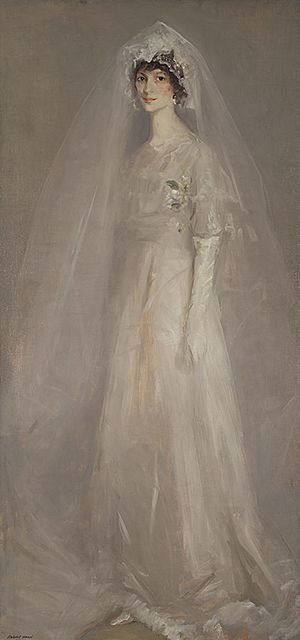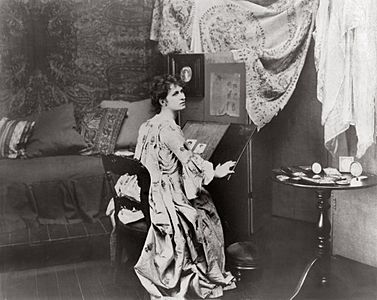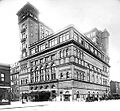Eulabee Dix facts for kids
Quick facts for kids
Eulabee Dix
|
|
|---|---|

Girl in Wedding Gown (Mrs. Eulabee Dix Becker), painting by Robert Henri, 1910.
|
|
| Born | October 5, 1878 |
| Died | June 14, 1961 (aged 82) |
| Nationality | American |
| Known for | Painting |
| Movement | Miniaturism, Still life |
Eulabee Dix Becker (born October 5, 1878 – died June 14, 1961) was an American artist. She loved painting tiny portraits called miniatures. She used watercolours on ivory, which is a smooth, white material. In the early 1900s, when these tiny paintings were very popular, she painted many important people. These included European nobility and famous actresses.
Contents
Eulabee Dix's Early Life and Art Interests
Eulabee Dix was born in Greenfield, Illinois. Her parents were Mary Bartholomew and Horace Wells Dix. From a young age, Eulabee loved art and reading. Her family always encouraged her talents.
When she was a teenager, Eulabee lived with wealthy relatives in St. Louis. There, she studied at Washington University. She spent a year learning oil painting and drawing at the St. Louis School of Fine Arts. Her work was so good that she won two medals!
In 1895, Eulabee moved with her parents to Grand Rapids, Michigan. She taught art classes there. She was inspired by a minister's daughter to start painting portrait miniatures.
Studying Art in New York City
In 1899, Eulabee Dix moved to New York City. She first tried studying with a famous artist named William Merritt Chase. But she left after only one week. She didn't like that he focused only on oil painting. She also disagreed with his ideas about color.
So, she continued her studies at the Art Students League. There, she learned from George Bridgman. She also had lessons with William J. Whittemore. He taught her the special way to paint on ivory. Whittemore was a founder of the American Society of Miniature Painters (ASMP). Eulabee showed some of her work there. She also studied with Isaac A. Josephi, who was the first president of the ASMP.
Her Studio at Carnegie Hall Towers
Eulabee Dix rented a small studio apartment in one of the Carnegie Hall towers. It was on the 15th floor at 152 West 57th Street. Here, she painted portraits for many important New Yorkers. These included the actress Ethel Barrymore and the photographer Gertrude Käsebier.
Her neighbor, Frederick S. Church, was also from Grand Rapids. He helped her meet other artists in New York. Another miniaturist, Theodora Thayer, whom Dix admired, also had a studio nearby.
Becoming a Recognized Artist
Even though she didn't have a lot of money, Eulabee always dressed very stylishly. She also held regular Friday afternoon parties at her studio. She would show her paintings to people who might want to buy them.
In 1904, Dix met Minnie Stevens Paget. Minnie was a close friend of King Edward VII of England. She was also married to Arthur Henry Fitzroy Paget, a high-ranking British Army officer. Eulabee and Minnie became close friends. Because of this friendship, Eulabee started spending her time between New York and London.
When she was in London, she lived in a fancy hotel in Kensington. Through Minnie Paget, Eulabee received many painting jobs. She painted the famous actress Ethel Barrymore in Philadelphia around 1905. She also painted fashion designer Countess Fabricotti and several portraits for Minnie Paget herself.
Starting in 1906, Dix traveled to Europe many times. There, she could see more old miniatures and European paintings than in America. She had her first art show called Exhibition of Portrait Miniature by Miss Eulabee Dix. It was at the Fine Art Society on London's New Bond Street. She showed 24 of her works there. That same year, she also had shows at the Royal Academy of Arts in London and the Walker Art Gallery in Liverpool.
In New York, Eulabee had the chance to paint the famous writer Samuel Langhorne Clemens. He is better known by his pen name, Mark Twain. In 1908, she painted the last portrait of him while he was still alive.
Eulabee Dix as a Painting Subject

Eulabee Dix herself was painted by the famous artist Robert Henri. She met him in 1910 through the Irish artist John Butler Yeats. For one of these paintings, she posed in her wedding dress.
Her friend, photographer Gertrude Käsebier, also took photos of Eulabee at least four times.
Marriage and Family Life
On December 22, 1910, Eulabee Dix married Alfred Leroy Becker. He was a lawyer in New York. They had been engaged for three years. They had two children, Philip and Joan.
The marriage ended in 1925, after 15 years. It was a difficult marriage partly because both Eulabee and Alfred had successful careers.
Later Life and Challenges
After her divorce in 1925, Eulabee sailed to France with her children. She then spent her time between Europe and New York. She won a medal at the Paris Salon art show in 1927. She also won awards in New York and Philadelphia in 1929.
The stock market crash of 1929 and the Great Depression that followed affected Eulabee's work. Many of her wealthy clients lost their money. She became frustrated with her art career. Her son, Philip, went to live with his father.
Eulabee moved to East 57th Street in New York. She lived there for about seven years. Even though she lived in a working-class area, she still dressed in fancy clothes. She always wore a hat and carried a cane.
In the 1930s, miniature painting became less popular. So, Eulabee gave talks about how to paint miniatures. She also changed her style. She started painting flowers and larger oil paintings.
In 1937, her daughter got married. Eulabee then moved to Southern California. She first lived on a ranch near Santa Barbara. She even briefly joined a group of monks who taught about peace and simple living. This experience helped her feel calmer.
Final Years and Legacy
During World War II, Eulabee Dix worked for the Plas-Tex Corporation. She painted radium on airplane parts. This work caused her to be exposed to radiation, which later gave her a small pension. After this, she worked in a laundry and drilled holes in airplane parts. She was proud to help with the war effort, but her painting almost stopped.
Her last miniature portrait was of her granddaughter, Elizabeth Becker. She started it in January 1950 but couldn't finish it because her eyesight was failing.
Her last portrait job was in 1951 for Kaufman Thuma Keller, who was the head of the Chrysler Corporation. But her worsening eyesight meant she couldn't finish that painting either.
In 1956, when she was 78, Eulabee sold her belongings and moved to Lisbon, Portugal. In 1958, an exhibition of her life's work was held there at the Museu Nacional de Arte Antiga. It was her last art show. Newspapers in New York and Portugal wrote articles about it.
Her last portrait, a head and shoulders painting, was done in Lisbon around 1958. It is believed to be of the wife of the American Ambassador to Portugal. This painting is now on loan to the Museum of Nebraska Art.
Eulabee Dix returned to the United States in 1961. She moved in with her son and his wife in Woodbury, Connecticut. On June 14, 1961, Eulabee Dix passed away. She was buried at Bellefontaine Cemetery in St. Louis.
Eulabee Dix's artwork is displayed in several important places. These include the Metropolitan Museum of Art in New York, the Museu Nacional de Arte Antiga in Lisbon, and the National Portrait Gallery in Washington, D.C. The Museum of Nebraska Art has Robert Henri's wedding portrait of Dix and many of her own paintings.
The National Museum of Women in the Arts has over 86 of her paintings. They also keep her letters, journals, and other writings. They even have her painting palette, brushes, and awards. This collection, called the Eulabee Dix Papers, was given to the museum in 1989 by her daughter, Joan Becker Gaines.
Images for kids
-
Eulabee Dix, Philip Dix Becker, 1912, watercolor on ivory, 3" in diameter, Metropolitan Museum of Art, New York
See also
 In Spanish: Eulabee Dix para niños
In Spanish: Eulabee Dix para niños









